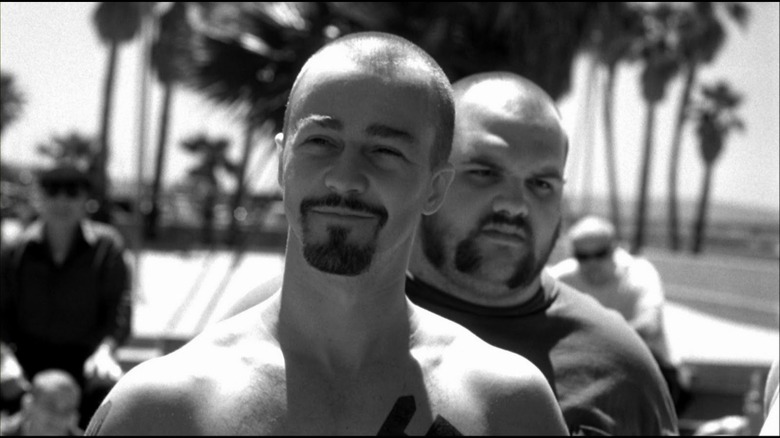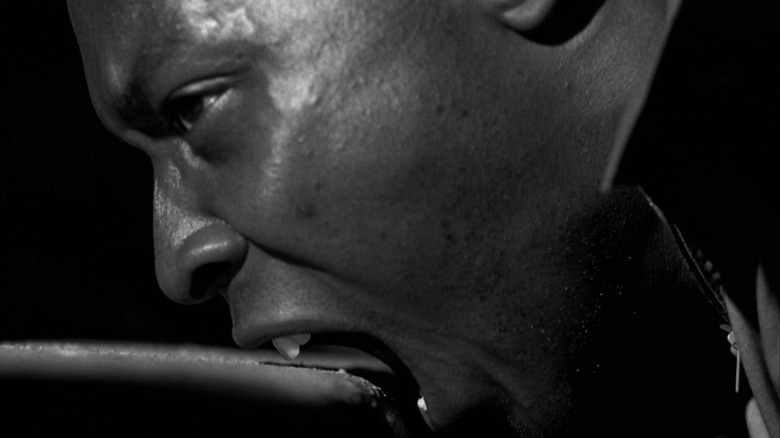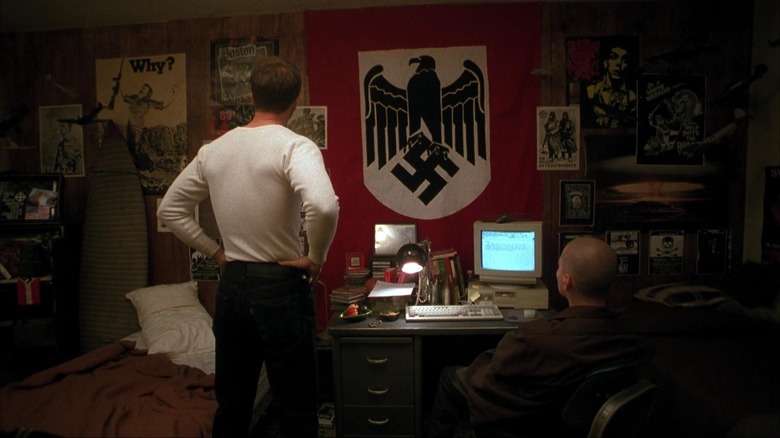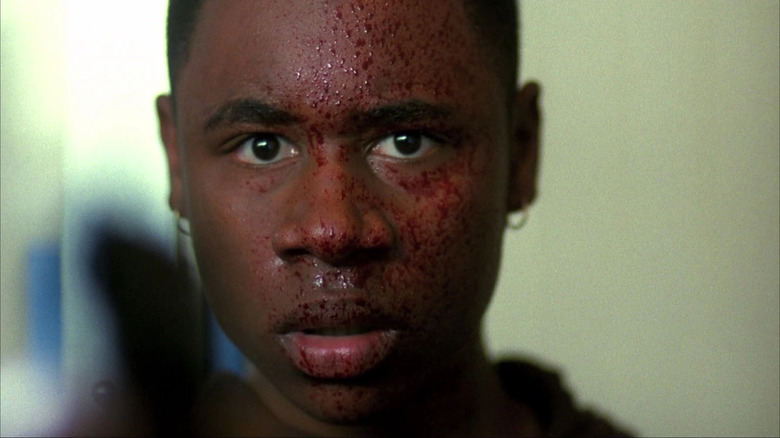How American History X Made That Infamous Curb Stomp So Convincing
It's rightfully considered a contender for being one of the most disturbing scenes ever filmed — yet, anyone who has watched "American History X" knows that its curb-stomp scene, though brutally visceral, is far from the only moment of discomfort and horror found in a tale about a Venice Beach gang of neo-Nazis, called the Disciples of Christ (D.O.C.). Every second of the film permeates with their vividly racist rhetoric and cruel acts of terror against the people of color who live in their neighborhoods. The grocery store raid is particularly difficult to watch, especially the tormenting of the female cashier as the men dump food they think is representative of her race on her before pouring milk on her to make her look white. Rewatching the film today, despite how prescient its forewarnings of homegrown white supremacist acts of terror are, is hard to do as a brown person.
But discomforting, violent moments also punctuate Derek Vinyard (Edward Norton) as he goes from being an insecure youth wrestling grief and rage, to a white supremacist prodigy, to a sibling trying to keep his little brother from going down the same path. It's the curb stomp that sends Derek to prison, which in turn causes his little brother to fill the void by joining the neo-Nazi gang he helped start. It's also in prison where he's raped by members of its Aryan gang, a betrayal that forces the issue of rethinking his racist and simplistic ideology. Yet the curb stomp remains the moment ingrained (for better or worse) in the minds of audiences who've made it through "American History X." Its gut-wrenching realism almost makes going behind the scenes of its filming rather surreal — but maybe hearing how they accomplished it will take the edge off its viciousness.
Dummy heads and rubber concrete
Creating the curb stomp required a number of problems to be solved before it could be filmed. One of the main ones involved how director Tony Kaye intended to shoot the scene. According to Far Out Magazine, they decided on crafting a dummy of actor Antonio David Lyons' head.
"[They] made a dummy of Antonio's head so that from the wide shot you can see the thing get crunched. It didn't look anything like the actor. It was just a bouncy head thing so you could stomp on it time and time again."
It's a blink if you miss it moment, one that lasts milliseconds as Norton's character slams his boot down with a sickening crunch. What makes the horror all the more unnerving is the anxiety-laden close-up we get of Lyons just a frame before — one that sees his open mouth hovering above the concrete a split second before his life ends. "To me, the kind of nerve-jangling thing is the close-up of the teeth grazing the curb," Kaye said of the shot and its necessity.
Lyons, on the other hand, had some concerns:
"I was a bit sort of concerned about that. I was, like, We're in Santa Monica. Dogs walk around and piss on this!'"
It's almost comforting that the worst thing being worried about during one of the film's most violent scenes was sanitation — which, fair point by Lyons (I wouldn't recommend going around biting down on the curbs anywhere in Los Angeles). So, instead they also created a faux rubber curb that the actor could put his mouth on without worry of germs, thereby creating one of the most agitating shots in modern cinema: the image of Lyon's luminous white teeth scraping the concrete.
What a curb-stomp says about the stomper
Obviously, the goal of the dummy head and getting a close-up of Lyons was to make the scene as grisly as possible — but not just for the shock and awe of the act. As studio executive Mike De Luca explained:
"It occurs fairly early in the movie, you haven't really gotten to know Edward Norton's character yet. So the scene itself needed to be so brutal that it told you what you needed to know about him in a fairly economical way."
One of the reasons the film was so controversial and subsequently praised when it was released was it dispelled any myths that extremist racism was fringe or unorganized. Here it was thriving, being cultivated in '90s Southern California by men like Norton's character, the muscular and charismatic Derek — a portrayal itself that sometimes inadvertently glorifies the man he was before he's shown the error of his ways. Similarly, there's so much egregious violence and vile racism espoused in "American History X" that it can't just be there for its jarring value, as that would just contribute to normalizing such images and ideologies. Instead, Derek's mercilessly savage murder of Lyons' character is meant to be an expedient definition of just how far off the deep end he is. Revealing exactly where such racist, hateful rhetoric leads: a heinous act of violence that shatters the lives of everyone — including its instigator.
An incomplete history in American History X
One of the unfortunate ways "American History X" ironically falls short is its treatment of characters of color. Often relegating them to the role of antagonists like rival gang members, helpless victims, or teachers burdened with the task of educating white supremacists. But that didn't prevent some of the cast from trying to give a voice to the experiences of black and brown communities that lived alongside the neo-Nazis of "American History X." Lyons explained his performance during the curb-stomp scene was one such statement:
"The truth that you hold in your mind is that somebody is killing you because of the colour of your skin. It is a violation of the human spirit. So even up to the last moment, he doesn't go down willingly. The sounds that you hear while Lawrence has his teeth on the curb is me trying to articulate that you can't kill us all. That to me was the crux of the character."
In the scene, Lyons' character Lawrence is obviously reluctant to obey Derek's commands to put his teeth on the curb. But given he's already been shot he really doesn't have much of a choice — so his defiance comes from both an unwillingness to die and a bitter acceptance of it.
Lyons' view of the scene is an important reminder that there's a whole other world that goes unexplored in "American History X." Although it's a comprehensive tale of Derek's road to redemption beyond neo-Nazism, it's not a complete portrait of race in America. Which the director is probably well-aware of given the fact he has plans to do an "American History Y," which will star Djimon Hounsou and perhaps finally explore the experiences of people of color.



